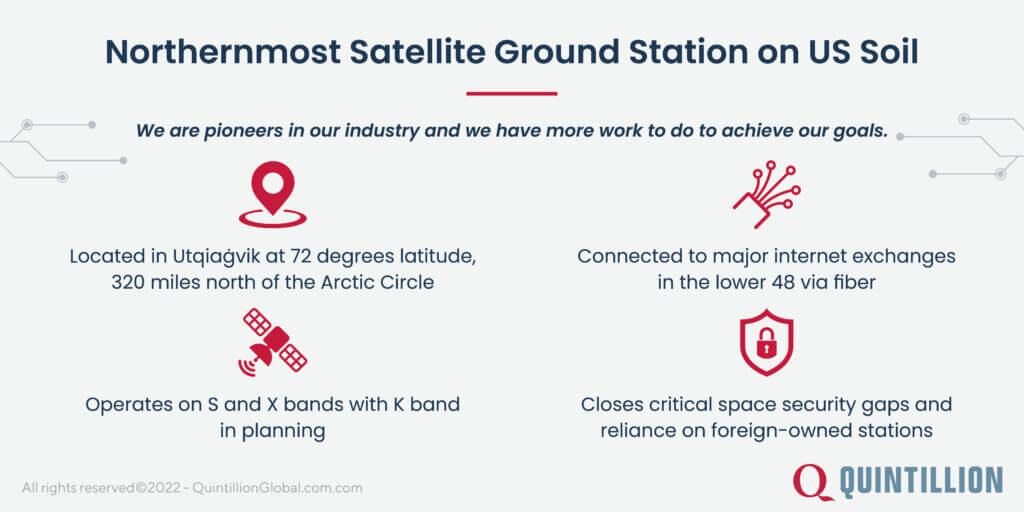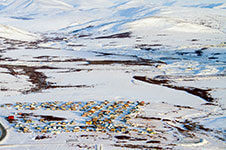For many, outer space symbolizes the ultimate frontier. It is a place that sparks curiosity, adventure, and opportunity. In the past, this interstellar realm may have primarily served as a landscape for fantasy, but our relationship with space has changed.
While outer space still holds much of its mystique, space-based technology and communication tools have become an integral part of life on Earth. Satellites have unlocked endless opportunities to better understand, monitor, analyze, and defend the planet.
With a major boom in satellite technology, our innovative team at Quintillion decided to take the plunge into the growing space industry as a provider of ground services. As an Alaska-based fiber optics company with operations in Utqiaġvik — the northernmost location in the United States — we knew we had several unique advantages to bring to the market. For this blog, we sat down with our Chief Revenue Officer, Mac McHale, to get the story behind why Quintillion decided to go “up” in its strategy.
Quintillion’s In, Out, and Up Strategy
Quintillion’s fiber optic network runs through the land, the sea, and is now connected to outer space. Our story begins in Alaska, where we became the first and only telecommunications operator to build a subsea and terrestrial fiber optic cable network in the US Arctic. This network spans 1,700 miles, with 1,200 miles of subsea fiber cables and 500 miles of terrestrial fiber originating in Nome and transiting along the west coast and North Slope to Oliktok Point, then south to Prudhoe Bay and Fairbanks, and then terminates in Seattle.
The current Alaska network is the “In” part of our strategy. It provides a fiber backbone that last-mile service providers in Alaska use to serve the markets of Nome, Kotzebue, Wainwright, Point Hope, Utqiaġvik, and Prudhoe Bay/Deadhorse (including the oil and gas infield). Future phases of this project will extend the network “Out,” where we’ll connect the Alaska cable system to Asia and Europe through the Arctic.
The last piece of the puzzle is our “Up” strategy, which includes the Quintillion High Latitude Data Acquisition (HiLDA) ground station. This station was built in Utqiaġvik at 72 degrees latitude. It was designed to service polar-orbiting satellite companies that need to downlink data to a ground station. It is from here that Quintillion’s fiber optic cables run and connect to the major Internet exchanges, including the Equinix Exchange in Seattle.

Why Quintillion Entered the Space Industry
When considering the idea of entering the growing space services market, it became clear that Quintillion had several unique advantages.
High-Latitude Location
Quintillion’s fiber optic cable system lands in Utqiaġvik, which is the northernmost city in the United States and one of the highest-latitude locations in the world. With several natural geographic advantages, this city was an obvious choice for building the HiLDA ground station. A high-latitude ground station enables companies or organizations launching polar-orbiting satellites into space to deliver data multiple times a day as close to real-time as possible. With Quintillion’s ground station, satellite operators can downlink data utilizing a majority of the satellite passes per day.
Secure Location
The HiLDA ground station was built on US soil. This provides US-based companies, government or military organizations, and American allies a neutral, secure location to downlink and process data from space. Additionally, the remote location is not easily accessible, which provides an extra layer of security against possible adversaries. The ground station is further protected with stringent physical protection and cybersecurity measures which include data encryption, access control, and personnel screening.
Fiber Infrastructure
Fiber optic cables are the most reliable and fastest way to relay information gathered from satellites to its intended destination. While many ground station providers rely on other companies to provide a fiber optic cable network they can utilize, Quintillion has the advantage of already owning a fiber optic network. This allows us to not only bundle fiber with our ground station services, but to connect the downlinking facility to major internet exchanges in the lower 48 via fiber as well.
Our Partners
In building the Quintillion HiLDA site, we worked with several of our partners to create a business plan and see the project through to completion. Our partners included:
- ASTAC: the premier local telecom operator on the North Slope
- ASRC Federal: a division of the largest regional Alaska Native corporation
- ATLAS: the developer of the award-winning Freedom™ Software platform
By partnering with Alaska companies and ATLAS, we were able to develop a qualified team with project management and engineering expertise. Additionally, when planning this project, we didn’t need to bring in people from the lower 48. We were able to work with Alaskans who were not only familiar with the hostile environment of Utqiaġvik in the winter, but who were also up to the challenge.
The Capabilities of the HiLDA Ground Station
The Quintillion HiLDA Ground Station services two main markets: satellite operators who require occasional downlinking services and those who need a dedicated ground station operator. Below is a breakdown of how operators can utilize this new downlinking facility.
Ground Station as a Service
For operators whose downlinking needs are less predictable, we offer Ground Station as Service. With this model, we own the equipment, and operators pay for the downlink as they need. This can be paid on a per minute or per pass basis.
ATLAS is the “secret sauce” to making the Ground Station as a Service work. The ATLAS Freedom™ Software allows operators to dedicate time on their ground station antenna in Utqiaġvik using a user-friendly AWS Cloud Digital Interface.
This sophisticated process essentially allows operators to coordinate when the satellite will come into view of the ground station, move the antennae, pick up the satellite, collect the data, and possibly even deliver that data back to the satellite for processing elsewhere.
This feature offers satellite operators a huge advantage. There are hundreds of satellites in the sky — soon to be thousands — and they are passing around the Earth multiple times a day. With this platform, operators who utilize HiLDA for GSaaS can simply and effectively schedule time on the antenna, including polar orbit passes and data delivery, as though it was their own.
Dedicated Ground Station Operator
The second option operators have is to use the HiLDA Ground Station as a dedicated ground station operator. This is the ideal option for satellite operators who have enough satellites to utilize the ground station on an almost full-time basis.
With this model, the operator would build an antenna at the Utqiaġvik facility and lease a dedicated antenna pad. We would provide continued operation and maintenance (O&M), in addition to the fiber connection and the link to the cloud. This would afford operators maximum flexibility.
The Future of Quintillion’s Space Strategy
Moving forward, we stand ready to support the growing need for satellite ground services for both commercial, government, and military purposes. As more and more satellites are launched into orbit, we understand that a diverse, redundant system is essential for keeping data safe and preserving national security.
At our HiLDA Ground Station, we have multiple options for expansions adjacent to our facilities and are ready to meet the demand of the booming satellite industry. We are currently in the process of building two additional platforms that will put out additional S and X bands, along with Ka and Ku bands.
The HiLDA Ground Station is built and ready for use. It offers a wide range of services, from GSaaS capabilities to a dedicated platform bundled with O&M, cloud services, power, equipment colocation, and backhaul solutions.
Are you looking for a ground service solution for your satellite data? Contact the Quintillion team to learn more.















